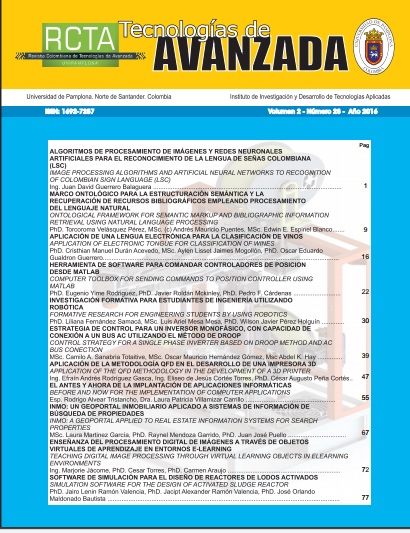Nuevo fluido orgánico para aplicaciones de ciclos de potencia rankine orgánicos con fuentes de calor sensibles
DOI:
https://doi.org/10.24054/rcta.v1i37.1264Palabras clave:
Dióxido de carbono, hidrofluorocarbono, ciclo Rankine orgánico, calor residualResumen
Invertir en el estudio de procesos de generación de potencia que conduzcan a la reducción de las emisiones de gases de efecto invernadero y permitan el aumento de la eficiencia energética, al aprovechar al máximo las fuentes de energía disponibles, es una estrategia fundamental para mitigar el impacto antrópico en el calentamiento global. Con esto en mente, en el presente trabajo se desarrolla un análisis detallado del uso de un nuevo fluido orgánico de tipo mezcla constituida por CO2 (dióxido de carbono) y un hidrofluorocarbono HFC-161 en un ciclo de potencia Rankine movido por una fuente de calor sensible de baja temperatura (150 ° C). Los análisis preliminares permitieron identificar el impacto de la mezcla sobre la eficiencia y potencia del ciclo, así como, aspectos benéficos de este nuevo fluido de trabajo para generación de potencia a partir de un parámetro de mérito normalizado de carácter ambiental
Descargas
Referencias
Andreasen J. G., Larsen U., Knudsen T., Pierobon L. y Haglind F. (2014) Selection and optimization of pure and mixed working fluids for low grade heat utilization using organic Rankine cycles, Energy, Vol. 73, pp. 204-213.
Bertrand F. T., Lambrinos Gr., Frangoudakis A. y Papadakis G. (2011) Low-grade heat conversion into power using organic Rankine cycles – A review of various applications, Renewable and Sustainable Energy Reviews, Vol. 15, pp. 3963-3979.
Chang Y., Lee J. y Yoon H. (2012). Alternative projection of the world energy consumption-in comparison with the 2010 international energy outlook. Energy Policy, Vol. 50, pp. 154–160.
Ennio M. y Marco A. N. (2017) Organic Rankine Cycle (ORC) Power Systems Technologies and Applications. Editorial Elsevier Science.
Hussam J., Navid K., Sulaiman A., Bertrand D., Amisha Ch. y Savvas A. Tassou. (2018) Waste heat recovery technologies and applications, Thermal Science and Engineering Progress, Vol. 6, pp. 268-289.
Lasala S., Chiesa P., Di Bona D. y Consonni S. (2014) Vapour – Liquid Equilibrium Measurements of CO2 based Mixtures: Experimental Apparatus and Testing Procedures, Energy Procedia, Vol. 45, pp. 1215-1224.
Lorentzen G. y Petterssen J. (1993) A new efficient and environmentally bening system for car air conditioning. International Journal of Thermal Sciences, Vol. 16, pp. 4–12.
MathWorks (2017) Available: https://www.mathworks.com/help/gads/gamultiobj.html.
NIST. (2013) REFPROP Version 9.1. Available in: https://www.nist.gov/srd/nist23.cfm.
Noriega S. Carlos J., Gosselin L. y K. da Silva A. (2018) Designed binary mixtures for subcritical organic Rankine cycles based on multiobjective optimization, Energy Conversion and Management, Vol. 156, pp. 585-596.
Pearson A. (2005) Carbon dioxide - new uses for an old refrigerant. International Journal of Refrigeration, Vol. 28, pp. 1140–1148.
Sánchez N. Carlos J. y K. da Silva Alexandre. (2018) Technical and environmental analysis of transcritical Rankine cycles operating with numerous CO2 mixtures, Energy, Vol. 142, pp. 180 -190.
Sarbu I. (2014) A review on substitution strategy of non-ecological refrigerants from vapour compression-based refrigeration, air-conditioning and heat pump systems. International Journal of Refrigeration, Vol. 46, pp. 123–141.
You-Rong Li, Mei-Tang Du, Chun-Mei Wu, Shuang-Ying Wu y Chao L. (2014) Potential of organic Rankine cycle using zeotropic mixtures as working fluids for waste heat recovery, Energy, Vol. 77, pp. 509-519.
SITIOS WEB
IEA. (2016). Key world energy statistics. http://large.stanford.edu/courses/2017/ph241/kwan1/docs/KeyWorld2016.pdf. (Consultado: 02 de Agosto 2019)
Johnson I., Choate W. T. y Davidson A. (2008) Waste Heat Recovery. Technology and Opportunities in U.S. Industry. https://www.osti.gov/servlets/purl/1218716. (Consultado: 28 de Julio 2019)
Descargas
Publicado
Número
Sección
Licencia
Derechos de autor 2021 Carlos Javier Noriega Sánchez, Nelson Afanador García, Gustavo Guerrero Gómez

Esta obra está bajo una licencia internacional Creative Commons Atribución-NoComercial 4.0.











